

























MIDWEEK UPDATE 23 AUGUST 2013

THIS WEEK IN MIDWEEK UPDATE
1 Weekend events.
2 Forthcoming events.
3 RV/Lotus Day at Kitty Hawk 18 August 2013.
4 SACAA: Notification of a proposal to issue an airworthiness directive.
5 Denel success story continues with another profitable year.
6 Pipistrel Taurus Electro G2 in serial production available on the market
7 We look at Chinese Military Aircraft: The Qiang-5.
1
24 August: Bela-Bela Falcons Flying Club - Neil Armstrong memorial fly in breakfast. Contact Pieter Roux 083 377 5227 or E-mail Info@justforfun.co.za
2
30 & 31 August: Bethlehem Airshow. For more information contact Derek O'Connor 083 629 5242 derek@malutiskies.co.za
2 to 15 September: World Precision Championships - Germany: Contact Mary de Klerk e-mail: maryd@expandingbranding.co.za
7 September: Zandspruit Bush and Aero Estate airshow - Hoedspruit . Contact Martin den Dunnen 015 793 1192 info@zandspruit.co.za
28 & 29 September: Sport Aerobatics Cape Regionals - Mossel Bay Contact Annie Boon e-mail: chunge@mweb.co.za
29 September (Sunday): Grand Rand airshow - One of the finest on the annual calendar. Contact Carolyn Naude 011 827 8884 e-mail: carolyn@randairport.co.za
28 & 29 September: Sport Aerobatics Cape Regionals - Mossel Bay
Contact Annie Boon e-mail: chunge@mweb.co.za
5 October: Fun Rally, Grand Central. Mary de Klerk. For more information go to: www.sapfa.org.za or contact Mary de Klerk e-mail: maryd@expandingbranding.co.za
12 October: Secunda Airshow. Contact Leon le Roux 017 634 4925
12 October: TMG (Touring Motor Glider) Fly in Parys. Contact Marietjie van Niekerk 082 765 6670
2 November: Aero Club of South Africa annual awards ceremony at the Wanderers Club. Contact Sandra Strydom 011 082 1100 e-mail: membership@aeroclub.org.za
9 November: SAPFA Fun Rally Brits airfield: For more information go to: www.sapfa.org.za
8 to 10 November: EAA Sun 'n Fun Chapter 1503 Tempe Airfield Bloemfontein
Contact: Jack Onderstall 082 770 5505 e-mail: jack@cp.bftn.co.za
15 to 17 November: Mafikeng fly-in and hangar dance. For more information
E-mail: info@mafikeng-flyingclub.co.za or contact Connie Conradie 082 449 1546
30 November to 1 December: Sport Aerobatics ACE of Base - Baragwanath airfield. Contact Annie Boon e-mail: chunge@mweb.co.za
7 & 8 December: Wings and Wheels airshow at AFB Ysterplaat - Cape Town Contact Chris Teale e-mail: chris@ysterplaat.org.za
For the full 2013 calendar go to events calendar.
3
By Cheryl Smit

Trevor and I flew into Kitty Hawk in the RV 12 at 08:00 only to find that there were just two RV's on the ground. We were about to turn around and head back to Fly-Inn when the safety on the ground came through on the radio and informed us that there was definitely an RV Breakfast Day planned and we should land.
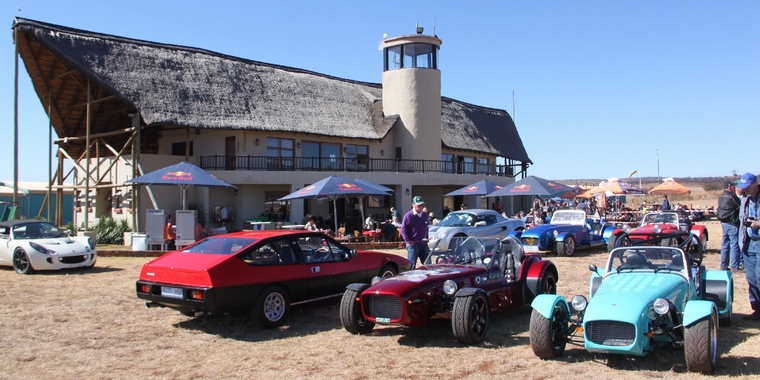
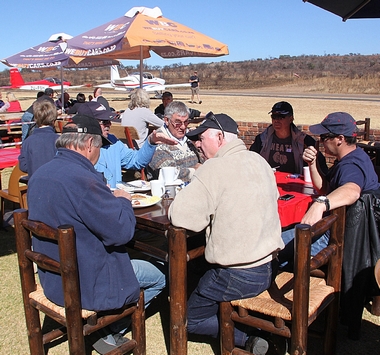
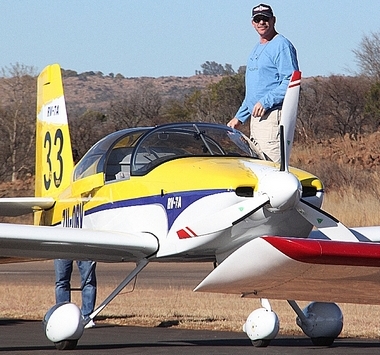
We landed just ahead of the RV formation, so I was able to get some pictures as the formation did their fly past. The RV formation flown by Paul Quick, Rob Kennedy and Ryan Beeton certainly stole the show on Sunday morning.
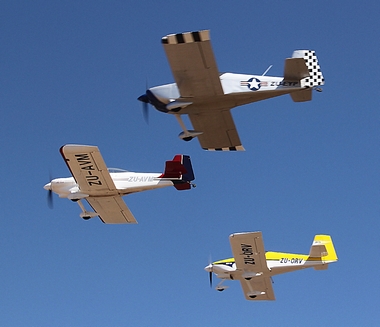
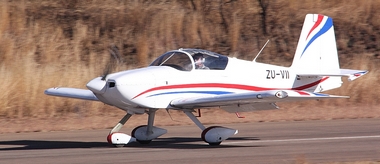
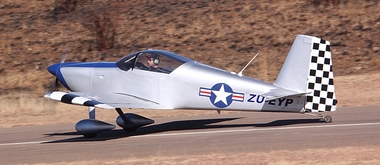
I counted 24 Lotus 7 kit cars, so they definitely out numbered the RV's on the day.
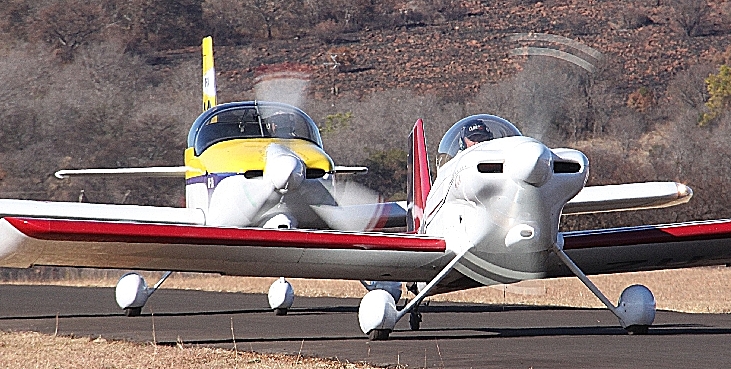
Rob Kennedy informed me that he was planning a much bigger RV contingent for the next breakfast Fly In, so I look forward to that and will report on Pilot's Post when it happens.
RSA PAD No: 13-002 Date: 8 August 2013
In accordance with the SACAA Continuing Airworthiness Procedures, the Director of Civil Aviation (DCA) is proposing the issuance of a RSA Airworthiness Directive (AD) applicable to the aeronautical product(s) identified below. All interested persons may send their comments, referencing the PAD number above, to the email address specified in the Remarks section, prior to the consultation closing date indicated.
Applicability: All aircraft with structures of tubular steel construction, semi-monocoque and monocoque construction, unless the manufacturer has a structural inspection or aging fleet program in place.
Reason:
This directive is published to highlight the critical requirements pertaining to inspections required to be carried out on aging aircraft including complete airframes, electrical, avionic and engine installations. Propellers and their associated parts are catered for under the Mid-life inspection requirements as published in the SACATS-43 document.
Effective Date: (TBD: 14 days after final AD issue Date)
Required Action(s) and Compliance Time(s):
1. Where applicable the following NDT techniques shall be used as inspection methods in cases where access to certain areas of the aircraft is made difficult:
? Low/High frequency eddy current
? Radiography
? Video/Optical fibre scopes (Boroscopes)
? Ultrasonic testing
? Magnetic particle
? Fluorescent Dye penetrant
1.1 A visual inspection may be carried out by the AMO involved in the completion of the MPI or phase inspection to all areas where no restrictions in access to various aircraft structures requiring inspection as per paragraph 3 of this directive exist. (Appropriate certification in the aircrafts technical records to be made by appropriately rated AMO's only).
1.2 When NDT inspections is required to be carried out, access to the various aircraft structures must be at its highest level e.g. at the time of a MPI or phase inspection and when Inspection panels are removed, open and accessible to NDT staff. When a repeat inspection is required, the approved NDT facility must indicate to the relevant AMO or aircraft owner / operator when the next inspection will be required in accordance with paragraph 2.2 and 2.3 of this AD.
1.3 AMO's carrying out inspections on aircraft requiring further inspections from approved NDT facilities must advise the NDT facility on the following information:
? Aircraft type
? Aircraft location
? Applicable SB, SL and AD requirements
? All other relevant information to aid in preparation of equipment and relevant techniques to be followed.
2. Frequency of inspections:
2.1 The appropriate visual and if required NDT method of inspection is to be performed at twenty five years from date of manufacture on aircraft in normal categories. This only applies to aircraft that does not have a continued airworthiness program or aging aircraft program as mentioned above. For crop spraying or aerobatic aircraft, the relevant NDT method of inspection must be carried out at a maximum of ten years from the date of manufacture.
2.2 The above mentioned inspections must be repeated after every five year period if no corrosion or crack indications are found.
2.3 Where corrosion is found during the initial inspection affecting any of the aircraft's structural parts, the relevant inspection method shall be repeated at least every two years by an approved AMO or approved
NDT facility.
3. Areas to be inspected (All aircraft):
3.1 All areas of inspection as called for by the manufacturer in their SB's, SI's and any other publications; for Cessna type aircraft compliance with the aging aircraft program is mandatory. (Continuous Airworthiness)
3.2 All areas concealed by ceconite coverings, fabric, sheet metal or composites.
3.3 Lapjoints of riveted structures
3.4 Wing spars
3.5 All castings or forgings
3.6 Door frames, rudder posts, ailerons, flaps and their attachment points, lift struts and built up parts or products.
3.7 Lower longeron and welded clusters
3.8 Rear fuselage of a tail wheel type aircraft
3.9 Any other areas prone to corrosion
4. Areas to which special attention must be given on all other aircraft types including Piper Aircraft and Hawker Beech aircraft types:
4.1 Wing to fuselage fittings
4.2 Carry thru attachment fittings
4.3 Areas around the left and right hand fuel tanks
4.4 Lift strut supports, attachments and fittings
4.5 Main and nose landing gear structures, attachments and wheel axles
4.6 Main landing gear actuators and saddle brackets.(Nose Landing Gear)
4.7 Engine mount welded tubular clusters and firewall attachments
4.8 Tail cone area-steel attachments on aluminium
4.9 Main and rear spar attachment to ribs, stringers, skins and centre section
4.10 Interior of fuselage hull and empennage
4.11 All control surface attachments
4.12 Elevator and rudder torque tubes
4.13 Circumferential and longitudinal lap joints
4.14 Main spar caps
5. Inspection requirements pertaining to piston and turbine engine power plants:
5.1 For all aircraft fitted with piston engines, the requirements of AIC 18-19 to continue engines in service which has accumulated 12 years calendar time since overhaul but has not exceeded the hourly life limit becomes mandatory with this directive.
5.2 For all aircraft fitted with turbine engines, the manufacturer's requirements remains mandatory as required by Part 43 of the South African Civil Aviation Regulations, 2011. CA 21-47 1 AUGUST 2013 Page 3 of 3
6. Actions to be taken on airframe related discrepancies:
6.1 Should cracks or corrosion be detected, the necessary corrective action shall be taken in line with the manufacturers recommendations and the Director of Civil Aviation notified within 48 hours.
6.2 All maintenance must be recorded in the appropriate logbook and the relevant NDT test reports and CRMA's affixed therein.
7. Documentation and preservation of records:
7.1 All documentation and records shall be preserved as required by the relevant CAR 43 & 145 applicable thereto.
8. Compliance:
At the next mandatory periodic inspection (MPI) or phase inspection which ever applies if not already accomplished when the aircraft attains the ages as specified in paragraph 2.1 of this AD or engines that's accumulated 12 years in service since overhaul. Compliance with this directive is not necessary if the manufacturer has a continued airworthiness program or aging aircraft fleet program in place Comply Within 12 Calendar Months of the effective date.
Ref Publications: As applicable by aircraft type
Remarks:
1. This Proposed AD will be closed for consultation on 08/09/2013.
2. Enquiries regarding this AD should be referred to the Certification Department, SACA at email adw@caa.co.za
5
Denel is a proudly South African company which provides the country's defence community with independence, security of supply and a consistent flow of innovative products and solutions based on world-class research and development. The changing nature of the global defence environment is driving demand for new technologies and Denel has responded to this by investing R528 million in Research &Development during the past year, including R142 million from its own funds. These investments will enable Denel to retain its competitive edge and provide the foundation for future growth.
Parallel to developing defence products and solutions for global markets, Denel continues to play a significant role in support of South Africa's national developmental priorities. These include skills and supplier development, maintaining advanced manufacturing and aerospace capabilities, growing the strategic technology base and creating skilled jobs that bring downstream benefits to broader society. At least R46-million was spent in Skills development within the 2012/13 financial year, dominantly focussed on engineering and technological disciplines.
As a key player in the global aerospace and defence landscape, Denel has earned international reputation in a number of niche areas which include guided missiles, global civil and related aviation sector, and artillery systems, to mention just a few.
Denel's capability (design, development, and manufacturing) is world-class, with technologies and products competing head-on with the leading international competitors. When viewed within the context of South Africa being a non-aligned developing country, mastering such technology and intellectual property is even more compelling to Denel's customers and partners.
Through our modern Aerostructures design and manufacturing capability, Denel has earned the position of being a respected and valued supplier to some of the major players in the global industry, including Airbus and Boeing.
Financial Performance:
Denel has seen a 10% improvement in revenue during the 2012/13 financial year. This can be attributed to a 34% growth in exports - from R1 329 million to R1 783 million - particularly within the company's missile and landward defence businesses.
Export revenue has grown in all of the company's key target markets, most notably in Africa, the Middle East, Asia-Pacific and South America. Local revenue amounts to 55% (R2 135m) of total revenue.
The net profit for the year has grown to R71m as a result of the increase in revenue, the restructuring of the company and a wide range of cost-saving initiatives. During the financial year, the company has integrated 11 businesses into six divisions, introduced measures to support the streamlining of operations and the sharing of support services across the group.
The operating expenditure has decreased from 27% to 24% of revenue, but the results continue to be affected by the interest on external borrowings and the financial losses posted by Denel Aerostructures. Operational savings and new contracts signed with Airbus Military on the A400M strategic airlifter have jointly contributed to a significant reduction in the losses incurred.
During the financial year, we successfully restructured the short-term debt of R1.185bn to a combination of short-term debt, three-year and five-year bonds to mitigate liquidity risks.
Denel's financial performance and our prospects for growth were recognised in the financial markets through an over-subscription on the Denel bond issue. During the year, Fitch Ratings revised the Denel long-term rating from negative to stable - which is a very positive achievement for the company considering the downgrades experienced by other companies and institutions during this period.
Stringent working capital management remains critical for the success of Denel as we continue with our growth strategy. Our profitability can be attributed to an increase in sales, an efficiency drive in which cost optimisation and discipline in the application of resources throughout the value chain was implemented.
People Management:
At Denel, our people are the key driver to business success. We have created an environment that attracts and retains skills that are critical not only to our business, but to the country. During the year under review, we have made a number of strategic appointments to strengthen the senior management of the company while also meeting our objectives for transformation and succession planning.
We will continue with our efforts to create a more diverse workforce, meet and exceed our employment equity targets and ensure adequate participation of black-owned businesses in our procurement and supply chain networks.
Our emphasis on training and youth development from high school to tertiary education levels are starting to show results through a growing pipeline of internal skills. Our approach is to “grow our own timber” through the allocation of bursaries to deserving learners and students, offer internships and extensive mentoring programmes to develop, nurture and retains our talent.
Denel continues to contribute to the objectives of the National Growth Path (NGP) in terms of skills development and in meeting our commitments towards artisan training, engineering studies and the skills required by South Africa's growing economy.
Significant Projects:
Among the key projects that Denel was responsible for during the 2012/13 financial year, are:
• Successful completion of humanitarian demining operations and the disposal of remnants of war in South Sudan, the Democratic Republic of the Congo, Senegal, Libya, Angola and Mozambique.
• Successful UAV surveillance service to SANPARKS in the Kruger national Park in support of anti-rhino poaching activities
• Progressing the final development and qualification of the A-Darter, 5th generation air-to-air missile in collaboration with our industry partners in Brazil and locally. The success of this project provides the benchmark and foundation for future technology collaboration among the BRICS nations.
• Initiating the development of the future-orientated Marlin missile project, aimed at establishing a common platform for long-range all weather air-to-air and surface-to-air defence capabilities. Denel is extremely appreciative of the close and strategic collaboration between Denel, the SANDF, Department of Defence and Armscor on programs like this.
• Concluding the development phase of the SANDF's Project Hoefyster to deliver a world-class infantry combat vehicle, the Badger, which will meet the requirements of a modern defence force. To date more than 100 local sub-contractors are actively involved in this programme and this impact will spread across the wider manufacturing sector once the green light has been given for the production order, which is sometime this year.
• We delivered the final Rooivalk combat support helicopter to the SA Air Force, reaching a major milestone in a project which bears testimony to the capability, skills and innovation that South Africa can offer to the world.
• Established a joint venture with Tawazun Holdings, a company owned by the government of the United Arab Emirates, for the manufacturing of guided munitions. Locally, Denel acquired LMT to strengthen our capacity in the landward vehicle market.
• Opened a Centre of Excellence at Denel Aviation during the recent BRICS Summit, which will provide extensive maintenance, repair and overhaul services to aircraft manufactured by Russian Helicopters. This initiative has been singled out as one of the first tangible results flowing from South Africa's participation in the BRICS alliance.
• Participated successfully at the Africa Aerospace and Defence Exhibition in Tshwane and maintained a strong marketing presence at a number of global industry events, including in Brazil, Paris, Turkey, Malaysia and the United Kingdom.
Future Perspectives:
An analysis of Denel's five year budget cycle indicates that there will be significant revenue growth over the medium term, and that the company will continue to be profitable and sustainable into the foreseeable future.
Our strategy is focused on significantly growing revenue, optimising costs and efficiencies, strengthening the balance sheet, transformation and modernising technology. The planned growth is backed by expected growth in our traditional markets, strong government support and strategic partnerships.
As our national defence force is becoming more involved in international peace-keeping missions in Africa, Denel remain committed to supporting our forces with leading edge technologies and products. This includes in the fields of observation, command and control, and other systems to enhance inter-operability. In short, we will be there when and where the SANDF needs us!
We expect important local projects in the fields of infantry combat vehicles, expanded ground-based air defence systems (GBADS), and the acquisition of aircraft for maritime reconnaissance which are currently in the pipeline will receive the green light in the coming year.
With regards the African continent, Denel will intensify our commitment through an optimised product and service offering as well as long-term collaboration rather than selling. We are already seeing the success of this strategy.
Our success in all these endeavours will make Denel profitable on a sustainable basis. I am positive about the future of Denel in light of the order pipeline, the successful transformation of our business, the quality of the human resources available to our company, and the industrial partnerships we have forged locally and internationally. The positive progress we have made during the year leads me to believe that Denel is certainly on a positive growth trajectory. It is indeed our time to shine for South Africa, Africa and the developing world.
Whilst rightfully proud about our recent operational achievements, we recognise the invaluable contribution of our loyal industry supply partners in South Africa.
Denel is a responsible national industry leader that values partnerships with other Industry-players in the country where those make business sense.
6
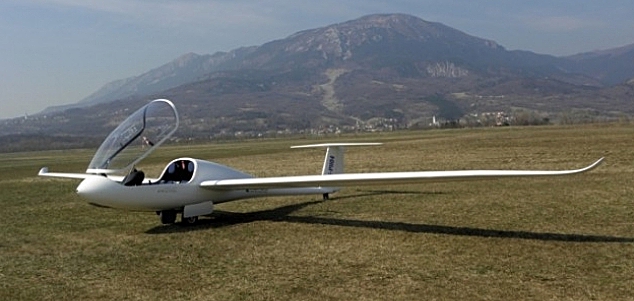
Pipistrel believes it is the only truly useful electric aircraft out there, because the electric drive is applied to the glider airframe, where battery capacity is not a limiting factor in performance/endurance. Taurus Electro G2 represents a leap forward in performance, safety, functionality and user friendliness.
Why the new generation?
Based on extensive testing of the Taurus Electro prototype, we decided not only to refine the product to serial production state, but rather to rethink, redesign and implement completely new solutions into the initial design. The result is what our Research and Development team calls Taurus Electro »Generation 2« or G2 in short. It is the production version and represents a great step up from the prototype The aircraft now has much better reliability, handling and performance.
Can electric perform better than conventional? Absolutely!
For the first time electric power outperforms its gasoline-powered counterpart - the Taurus. Taurus Electro G2 can use a shorter runway, climbs faster and is performs much better than the gasoline-powered version when it comes to high altitude operations. All this is possible thanks to the specially-developed emission-free Pipistrel's 40kW electric power-train.
The tailor-developed Lithium-technology batteries come in two configurations, capable of launching the aeroplane to 1200 m (4000 ft) or 2000 m (6500 ft) respectively. They are placed in self-contained boxes, monitored constantly by the super-precise Pipistrel's own battery management system (BMS), compete with data-logging and battery health forecasting.
The propulsion motor weighs an impressive 11 kg (rather than 16 kg) and generates 10 kW more power, resulting in a total of 40 kW. Due to this 33% increase in power and 40% decrease in weight we developed a whole new propeller, which has proven to be more efficient than the version flying on the Taurus Electro Prototype.
Taurus Electro is made in highest technology composites (epoxy resin, glass fibre, carbon fibre, kevlar fibre and honeycomb structures). The airfoil used on wings is ORL 170, (F. Orlando).
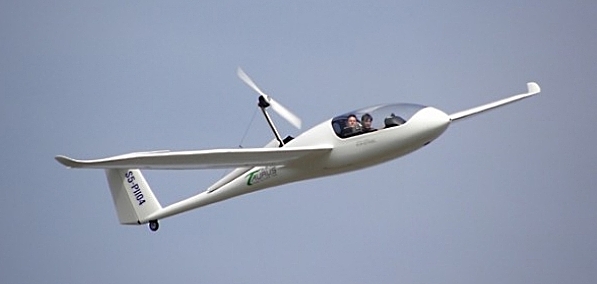
TAURUS ELECTRO G2 Specifications
Power plant: High performance synchronous 3-phase electric out runner with permanent magnets power. 40 kW for take-off, 30 kW continues
Propeller: 2 blade Pipistrel 1650 mm diam special for Taurus Electro G2
Wing span 14.97 m
Length 7.27 m
Height 1.41 m
Wing area 12.33 m2
Positive flaps 5 deg, 9 deg, 18 deg
Negative flaps -5 deg
Empty weight (includes standard battery!) 306 kg
Max take off weight (MTOW) 450 kg / 472.5 kg / 550 kg
Weight of standard battery system 42 kg
Stall with flaps 63 km/h
Stall without flaps 71 km/h
Manoeuvring speed 163 km/h
Max. speed with flaps extended 130 km/h
Max. speed with airbrakes extended 225 km/h (extend at or below 160 km/h)
Max. speed with powerplant extended 160 km/h
VNE 225 km/h
Best glide 1: 41
Best glide ratio speed 107 km/h
Take off run MTOW 160 m
Best climb speed 100 km/h
Max climb rate (MTOW) 3.1 m/sec
Max load factor permitted (x1,8) +5.3g -2.65g
Max load factor tested + 7.2g - 7.2g
7
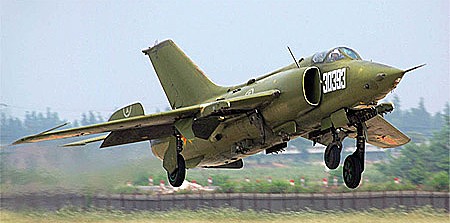
The Q-5 (Qiangji-5, or Qiang-5; export name: A-5; NATO reporting name: Fantan) is a twin-engine, single-seat, supersonic ground attack aircraft developed by Nanchang-based Hongdu Aircraft Industry Group. The main roles of the aircraft are air interdiction and close air support. Early variants of the Q-5 in service with the PLAAF and PLA Navy have now been replaced by the upgraded variants with improved navigation and precision strike capability. The PLA has been seeking a replacement to this forty-year-old design since the 1970s, but with no success. Instead, the aircraft has been steadily upgraded with new weapons and avionics to extend its service life.
The Q-5 was developed from the Shenyang J-6 (MiG-19 Farmer copy) fighter. The Q-5 inherited the wing and tail of the J-6, but has a redesigned fuselage featuring a solid nose with lateral air intakes. The increased airframe weight and modified profile have resulted in the Q-5 being less manoeuvrable. The Q-5 is 1,360kg heavier than the J-6 and its maximum speed is 0.23 Mach slower. The Q-5 is also inferior to the J-6 in maximum climb rate and service ceiling, and requires longer runway for take-off and landing. Additionally, in order to give room for additional avionics and armaments, the internal fuel capacity had to be reduced, resulting in a shorter combat radius.
The Q-5 has a downward-sloping profile nose that provides the pilot with better visibility. The wings are mid-mounted, sharply swept-back, and tapered. The tails are also swept-back and tapered. Early variants of the Q-5 has a fuselage weapon bay but this was removed on the later variant to accommodate more fuel in internal tanks. Two Wopen-6 turbojet engines are mounted side-by-side in rear of the fuselage with two hydraulically actuated nozzles. The semicircular lateral air intakes have small splitter plates. The cockpit and internal tanks have armour protections. The cockpit is fitted with a 3-piece windscreen and a rear-hinged canopy.
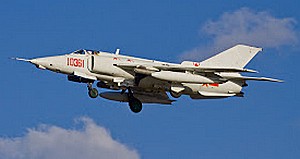
The Q-5 is equipped with the radio compass, radio altimeter, beacon receiver, and optical firing/bomb sight. The aircraft is equipped with a low-speed ejection seat identical to that of the J-6/MiG-19, which can operate at speeds between 250~850km/h. The aircraft is powered by two WP-6 turbojet engines, each rated at 25.5kN (2,600kg, 5,733lb) dry and 31.87kN (3250kg, 7,165lb) with afterburning. The aircraft can fly at near sonic speeds when carrying 1,000kg weapon load in its internal weapon bay without external payloads. When carrying a pair of 760 external fuel tanks, the aircraft can only fly at subsonic speeds. The Q-5 usually adopts a “lo-lo-lo” flight profile, which gives a maximum combat radius of 400km, or 600km when using a “lo-lo-hi” profile. The flight manual of the Q-5 also instructs that the flight speed should not exceed 0.98 Mach when flying at low altitudes.
 |
 |
 Copyright © 2024 Pilot's Post PTY Ltd
The information, views and opinions by the authors contributing to Pilot’s Post are not necessarily those of the editor or other writers at Pilot’s Post.
Copyright © 2024 Pilot's Post PTY Ltd
The information, views and opinions by the authors contributing to Pilot’s Post are not necessarily those of the editor or other writers at Pilot’s Post.